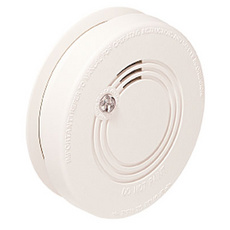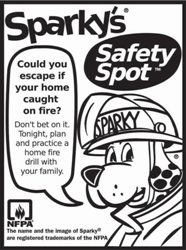
Almost three of five (60%) of reported home fire deaths in 2007 to 2011 resulted from fires in homes with no smoke alarms or no working smoke alarms. Make sure yours are working; test them every month! Fast Facts about Fire
Smoke alarms should be installed on every level of the home (including the basement), outside each sleeping area, and inside each bedroom. Larger homes may need additional smoke alarms. Never remove or disable smoke alarms.
Interconnection of smoke alarms is highly recommended; when one smoke alarm sounds, they all do. This is particularly important in larger or multi-story homes, where the sound from distant smoke alarms may be reduced to the point that it may not be loud enough to provide proper warning, especially for sleeping individuals. A licensed electrician can install hard-wired multiple-station alarms. Wireless alarms, which manufacturers have more recently begun producing, can be installed by the homeowner.

Test smoke alarms at least monthly by pushing the test button. If an alarm “chirps”, warning the batter is low, replace the battery right away. All smoke alarms, including alarms that use 10-year batteries and those that are hard-wired alarms, should be replaced when they’re 10 years old (or sooner) if they do not respond properly when tested.
Never remove or disable a smoke alarm.
Smoke Alarms and Fire Facts & Safety
Smoke Alarms
- Smoke alarms cut the risk of dying in a reported fire in half.
- Most homes (96%) have at least one smoke alarm (according to a 2008 telephone survey).
- Each year, nearly 3,000 people die in U.S. house fires.
- In 2003-2006, roughly two-thirds of home fire deaths resulted from home fires in hoes with no smoke alarms or no working smoke alarms.
- In more than half of the reported home fires in which the smoke alarms were present but did not operate even though the fire was large enough, batteries were missing or disconnected. Nuisance alarms were the leading reason for disconnected alarms.
- More then half of the smoke alarms found in reported fires and two-thirds of the alarms found in homes with fire deaths were powered by battery only.
- Most homes still have smoke alarms powered by battery only. In a 2007 American Housing Survey, 67% of the respond alarms said they were powered by battery only.
- In a 2008 telephone survey, only 12% knew that smoke alarms should be replaced every 10 years.
- In fires considered large enough to activate a smoke alarm, hard-wired alarms operated 91% of the time; battery-powered smoke alarms operated 75% of the time.
- Interconnected smoke alarms on all floors increase safety.
Fires
- Cooking is the #1 cause of home fires and injuries.
- Smoking is the leading cause of fire deaths.
- Heating is the second leading cause of home fires, fire deaths and fire injuries.
- Electrical failures or malfunctions are factors in roughly 50,000 reported fires each year.
- Roughly 30,000 intentionally set home structure fires are reported each year.
Safety
- City Ordinances requires UL-listed smoke alarms be installed in every room on an apartment or rental home. Homeowners, should follow these same guidelines.
- Make sure your smoke alarms work, working smoke alarms help provide early warning no matter where the fire starts, giving more to to escape.
- Test smoke alarms monthly and replace batteries as needed.
- Know two ways out. A fire escape ladder, such as one offered by Kidde, can provide an alternate exit for second or third floor rooms.
- Purchase a fire extinguisher and learn how to use it, before a fire breaks out.

Safety Tips for Kids
Smoke alarm and home fire escape planning
- If there is a fire in your home, there will be smoke
- A smoke alarm will let you know there is a fire.
- A smoke alarm makes a loud noise – beep, beep, beep
- When the smoke alarm sounds, get outside and stay outside.
- Go to your family outside meeting place.
When you go home today, be a smoke alarm detective
- Ask a grown-up to show you where the smoke alarms are in your home.
- Ask a grown-up to test the smoke alarms to make sure they are working.
Be a home fire escape planner
- Make a map of your home. Mark a door and a window that can be used to get out of every room. (Download the Home Fire Escape Plan (PDF, 632 KB) provided by National Fire Protection Association.)
- Choose a meeting place outside in front of your home. This is where everyone can meet once they’ve escaped. Draw a picture of your outside meeting place on your escape plan.
- Write the emergency telephone number for the fire department on your escape plan.
- Have a grown-up sound the smoke alarm and practice your escape plan with everyone living in your home.
- Keep your escape plan on the refrigerator and remind grown-ups to have your family practice the plan twice a year or whenever anyone in your home celebrates a birthday.
*Sources: National Fire Protection Agency (NFPA) *
